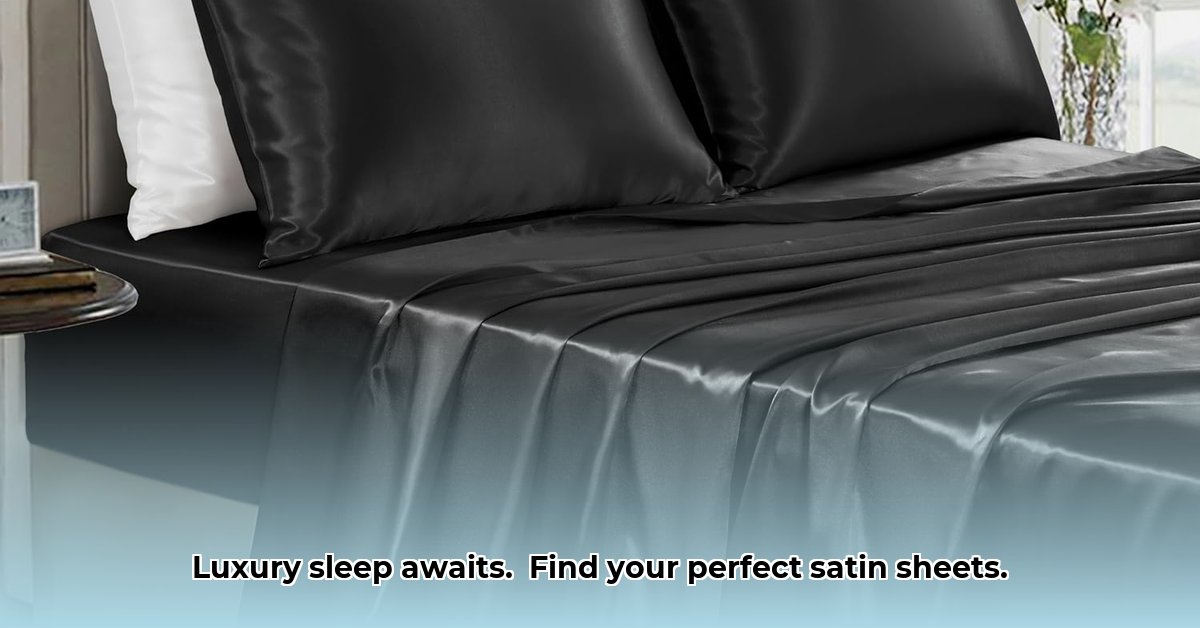Curious about the luxurious feel of satin sheets and how they can transform your sleep? This comprehensive guide eliminates the guesswork, empowering you to choose the perfect satin bedding for your needs. We’ll delve into satin types – silk, polyester, rayon, and innovative blends – explore crucial aspects like breathability, thread count, weave, certifications, and provide practical advice for every budget and lifestyle.
Unveiling the Secrets of Satin Sheets and Sleep Enhancement
Satin sheets are celebrated for their smooth, sensual texture and potential benefits for skin and hair. However, understanding what “satin” actually means is paramount to making an informed purchase. Remember, “satin” refers to a specific weaving technique, not a raw material. This technique creates a fabric with a glossy face and a dull back. Knowing this distinction unlocks the world of satin bedding.
Decoding Satin Types: A Comprehensive Material Comparison
The type of fiber used to create satin dramatically affects the sheets’ comfort, durability, care requirements, and overall cost. Let’s explore the most popular options in detail:
-
Silk Satin: The undisputed champion of luxury. Made from natural silkworm fibers, silk satin offers unparalleled softness, breathability, temperature regulation, and a beautiful drape. It’s also naturally hypoallergenic, making it an excellent choice for sensitive skin. The downside? A significantly higher price tag and the need for delicate hand washing or professional cleaning. Look for Mulberry silk for the highest quality.
-
Polyester Satin: The budget-conscious and readily available option. Polyester satin mimics the smooth feel of silk at a fraction of the cost. It’s also more durable and wrinkle-resistant than silk. However, it lacks breathability, potentially leading to overheating during the night. It can also feel less luxurious against the skin.
-
Rayon Satin (including Viscose and Modal): A plant-derived alternative that balances softness and affordability. Rayon satin, particularly those made from bamboo, eucalyptus (Tencel/Lyocell), or sustainably sourced wood pulp, offers a silk-like drape and breathability at a mid-range price point. However, rayon can be more prone to wrinkles and may require careful washing. Always prioritize sustainably sourced options due to the variable environmental impacts of rayon production.
-
Satin Blends: Innovative blends combine the best qualities of different fibers. For example, a silk-cotton blend can offer enhanced durability and breathability compared to pure silk, while a polyester-rayon blend can improve the drape and feel of polyester.
Here’s a detailed comparison chart:
| Material | Pros | Cons | Price Point | Care | Best For |
|---|---|---|---|---|---|
| Silk Satin (Mulberry) | Unparalleled softness, breathability, temperature regulation, hypoallergenic, luxurious drape, promotes skin and hair health. | Very expensive, requires delicate care (hand wash or professional cleaning), prone to snags. | High ($$$) | Hand wash or professional dry clean | Ultimate luxury, sensitive skin, temperature regulation, those seeking the best possible sleep surface. |
| Polyester Satin | Affordable, durable, wrinkle-resistant, widely available. | Less breathable, can feel less luxurious, may not be as gentle on skin and hair, can generate static. | Low ($) | Machine washable (cool water, gentle cycle) | Budget-conscious shoppers, those prioritizing durability and wrinkle resistance, those who don’t mind a less luxurious feel. |
| Rayon Satin (Tencel/Modal) | Softer than polyester, more breathable than polyester, silk-like drape, potentially sustainable (if made from responsibly sourced materials). | Can be more prone to wrinkles than polyester, may require more careful washing, environmental impact depends on sourcing (look for Tencel/Lyocell for sustainable options). | Mid-range ($$) | Machine washable (cool water, gentle cycle), may require ironing. | Those seeking a balance of softness, breathability, and affordability, eco-conscious shoppers (look for Tencel/Lyocell). |
| Satin Blends (e.g., Silk-Cotton) | Combines the benefits of different fibers (e.g., enhanced durability and breathability with silk-cotton), often more affordable than pure silk. | Properties vary depending on the blend, may require more research to find the perfect combination. | Mid-range ($$) | Varies depending on the blend (check care label). | Those seeking specific benefits from a combination of fibers, those looking for a more durable and/or affordable alternative to pure silk. |
Sustainability and Ethical Sourcing in the Satin Industry
In today’s world, considering the environmental and social impact of your purchases is crucial. The sustainability of satin sheets varies greatly depending on the material and manufacturing processes.
- Silk: Look for peace silk (also known as Ahimsa silk), which allows the silkworm to complete its metamorphosis before the silk is harvested. Traditional silk production involves boiling the silkworms alive.
- Polyester: As a petroleum-based product, polyester has a significant environmental footprint. Consider recycled polyester options to reduce your impact.
- Rayon: Opt for Tencel/Lyocell, which is made from sustainably sourced wood pulp using a closed-loop production process that minimizes waste and water usage. Always check for certifications like the Forest Stewardship Council (FSC) to ensure responsible forestry practices.
Certifications like the Global Organic Textile Standard (GOTS), OEKO-TEX Standard 100, and Fair Trade can help you identify products that meet specific environmental and social standards.
Key Features to Evaluate for High-Quality Satin Sheets
Beyond the material, several factors contribute to the overall quality, feel, and longevity of satin sheets:
- Thread Count: While higher thread count can indicate softer sheets, it’s not the only factor. Focus on the quality of the fibers and the weave. A thread count between 300 and 600 is generally considered ideal for satin sheets.
- Momme Weight (for Silk): Momme (mm) is a unit of weight used to measure the density of silk fabrics. Higher momme weights indicate a denser, more durable silk. Look for silk satin sheets with a momme weight of 16 or higher.
- Weave Type: A tighter weave enhances durability and reduces the likelihood of snags and pilling. Common satin weaves include charmeuse, crepe back satin, and duchesse satin. Charmeuse is the most common type for sheets due to its smooth, lustrous finish.
- Finishing Treatments: Some satin sheets undergo finishing treatments to enhance their softness, wrinkle resistance, or durability. Be sure to research the specific treatments used and their potential impact on the environment and your health.
- Deep Pockets: If you have a thick mattress, choose sheets with deep pockets to ensure a secure fit.
- Elastic All Around: Elastic all around the fitted sheet will help prevent it from slipping off the mattress.
- Price: While price isn’t always an indicator of quality, higher-priced satin sheets often reflect the use of higher-quality materials, more ethical production practices, and greater attention to detail.
Your Step-by-Step Guide to Buying the Perfect Satin Sheets
- Set a Realistic Budget: Determine how much you’re willing to spend on new satin sheets. Remember to factor in the long-term cost of care and maintenance.
- Define Your Priorities: What’s most important to you? Softness? Breathability? Durability? Sustainability? Price? Identifying your priorities will help you narrow down your options.
- Read Customer Reviews: Research different brands and satin types and pay attention to what other customers have to say about their experiences. Look for reviews that mention the sheets’ softness, breathability, durability, and care requirements.
- Check for Certifications: Look for certifications like GOTS, OEKO-TEX, FSC, and Fair Trade to ensure that the sheets meet specific environmental and social standards.
- Compare and Contrast: Use the comparison tables and information provided in this guide to compare different satin sheet options based on material, thread count, momme weight, weave type, price, and other relevant factors.
- Consider Color and Pattern: Choose a color and pattern that complements your bedroom décor and personal style.
- Check the Return Policy: Before making a purchase, be sure to check the retailer’s return policy in case you’re not satisfied with the sheets.
- Make Your Purchase: Select a satin sheet set that aligns with your budget, preferences, and values.
Caring for Your Precious Satin Sheets: Tips for Long-Lasting Luxury
Proper care is essential to maintaining the beauty and extending the lifespan of your satin sheets.
- Wash Gently in Cold Water: Use a mild, pH-neutral detergent specifically designed for delicate fabrics. Avoid harsh chemicals, bleach, and fabric softeners, which can damage the fibers and dull the sheen.
- Use a Mesh Laundry Bag: Protect your satin sheets from snags and tears by placing them inside a mesh laundry bag before washing.
3
- Glass Tile Shower Ideas to Create a Stunning Bathroom Space - December 7, 2025
- Glass Wall Tile Ideas for Kitchens and Bathrooms - December 6, 2025
- Glass Tile Bathroom: Create a Beautiful, Easy-Clean Space - December 5, 2025










